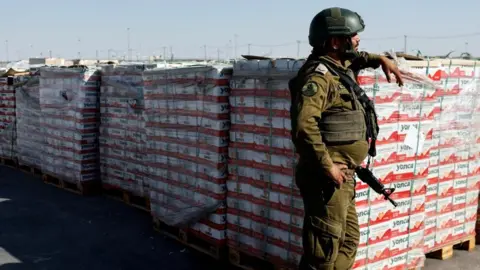Gaza Aid Crisis: Airdrops Criticized as Inadequate and Dangerous Amidst Starvation
The ongoing humanitarian crisis in Gaza has led to a surge in desperation, with international aid organizations increasingly critical of the reliance on airdrops. They warn that this approach is a “grotesque distraction” from the dire situation, as the population faces widespread starvation. Airdrops are seen as an insufficient and potentially dangerous measure that fails to address the core issues preventing the delivery of life-saving aid.
Israel, along with other nations like the United Arab Emirates, Jordan, and the United Kingdom, have begun airdropping humanitarian aid into the Gaza Strip. However, critics argue that this is a superficial response, incapable of delivering the necessary volume or quality of aid to avert a humanitarian catastrophe. The focus on airdrops has raised concerns about their effectiveness, safety, and whether they truly address the root causes of the crisis.
Ciarán Donnelly of the International Rescue Committee (IRC) stated that airdrops “could never deliver the volume or the quality” of aid required. This sentiment is echoed by over 100 international aid organizations and human rights groups, which have issued dire warnings about widespread starvation. Tragically, the Hamas-run Gaza health ministry has reported a significant increase in deaths due to malnutrition, with a devastating 127 fatalities since the war began, including 85 children.
The World Food Programme (WFP) paints a grim picture, reporting that one in three Gazans are going without food for days, and approximately 90,000 women and children are in urgent need of treatment. The situation is being characterized as a “man-made mass starvation,” highlighting the severity of the crisis.
Inefficiency and Risks of Airdrops
The increased reliance on airdrops stems from the persistent failure of aid to enter Gaza via traditional land routes. Philippe Lazzarini, the head of UNRWA, the UN’s Palestinian refugee agency, has been a vocal critic. He highlights the inefficiencies and risks of airdrops, stating that they are “expensive, inefficient, and can even kill starving civilians” if they go awry.
Lazzarini emphasizes that his organization has the equivalent of 6,000 trucks waiting in Jordan and Egypt, ready to deliver aid, awaiting permission to enter Gaza. He advocates for a practical solution: “lift the siege, open the gates and guarantee safe movements and dignified access to people in need.” He further elaborated: “Driving aid through is much easier, more effective, faster, cheaper & safer. It’s more dignified for the people of Gaza.”
Despite these criticisms, Israel has announced the establishment of “designated humanitarian corridors” for UN aid convoys. However, details about the location and operational procedures remain unclear. Israel maintains that there are no restrictions on aid entry, while the UN cites bureaucratic obstacles and safety concerns as major impediments.
A History of Inadequate Aid
This is not the first attempt to deliver aid to Gaza from the air. Past initiatives have proven largely insufficient in alleviating hunger and suffering. For instance, the UK’s Royal Air Force delivered 110 tonnes of aid over 10 drops as part of a Jordanian-led international air coalition. However, aid agencies have asserted that this is not nearly enough to address the scale of the crisis.
A recent analysis reveals the staggering numbers needed. Around 160 planes would be required to deliver enough food for a single meal for each of Gaza’s two million residents. U.S. Central Command (Centcom) data indicates that their C-130 cargo planes delivered approximately 12,650 meals per trip. More than 160 flights would be needed to provide a single meal to the population of Gaza.
With only a limited number of aircraft available for aid drops, such as Jordan’s approximately 10 C-130s and the UAE’s eight, the logistical constraints highlight the limitations of relying solely on airdrops.
Dangers on the Ground
In addition to logistical challenges, aid groups have raised serious concerns about the dangers of airdrops in a densely populated area. Shaina Low of the Norwegian Refugee Council described the harrowing scenes of people “drowning” while trying to collect aid that had fallen into the Mediterranean, and of falling boxes “crushing people.” She stated that even successful airdrops resulted in chaos, with people fighting over the aid and getting injured.
Gazans themselves express fear and concern about the potential for harm. One resident of northern Gaza told BBC Arabic’s Middle East Daily that airdrops are “unsafe” and have “caused numerous tragedies.” He warned, “When aid is dropped from the air, it risks landing directly on tents, potentially causing serious harm, including injury or even death.”
The immediate crisis is compounded by the urgent need for water. One mother shared with the BBC her desperate situation, stating, “We’re living with no food or drink, no food, no bread, not even water. We’re craving even water.”
The current situation in Gaza is a direct consequence of the conflict initiated by the Hamas-led attack on southern Israel on October 7, 2023. Approximately 1,200 people were killed, and 251 were taken hostage. Since then, the Hamas-run health ministry reports that over 59,000 people have been killed in Gaza.
Israel imposed a total blockade on aid deliveries in March 2024 and resumed its military offensive against Hamas, escalating the crisis. While the blockade has been partially eased, shortages of food, medicine, and fuel continue to worsen. The majority of Gaza’s population has been displaced, and over 90% of homes are damaged or destroyed.

